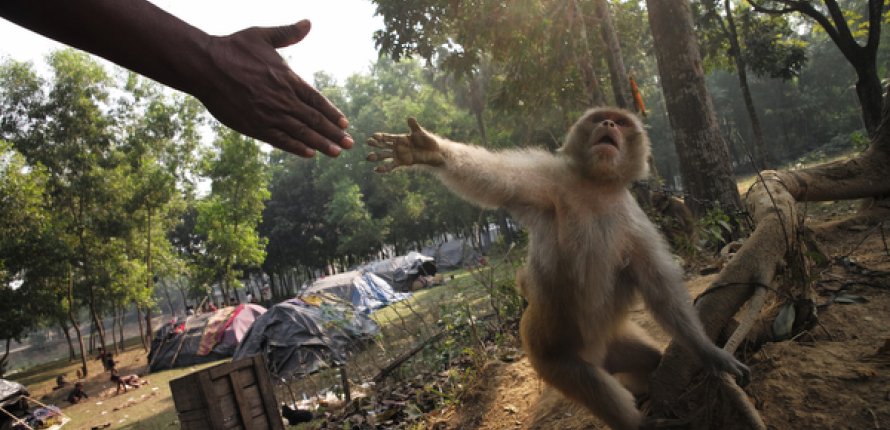Science Looks Before Viruses Leap

Lisa Jones-Engel, Senior Research Scientist at University of Washington
2014-2015 Core Fulbright Scholar to Bangladesh
Reposted with permission via www.FredHutch.org
What a semi-nomadic ethnic group — and their performing monkeys — can teach us about how viruses jump from animals to humans.
During 2006, Dr. Lisa Jones-Engel traveled to the Bangladeshi village of Dhamrai with her research team. There, she saw a man in his early 30s, walking down the side of the dusty road and carrying a canvas bag. The University of Washington primatologist yelled to her colleagues to stop the van. They pulled over and Jones-Engel jumped out. He would change the direction of her work over the next nine years, prompting Dr. Jones-Engel to pursue a Fulbright Scholar grant in 2014.
 Dr. Lisa Jones-Engel meets a performing Bedey monkey named Madhu (the Bengali word for honey).
Dr. Lisa Jones-Engel meets a performing Bedey monkey named Madhu (the Bengali word for honey).
Trailing behind the man was monkey on a leash. Jones-Engel immediately knelt down to make friends with the macaque. The animal’s owner was a member of the Bedey people, a semi-nomadic group that travels around Bangladesh and the surrounding countries, giving performances for cash with their trained (but, Jones-Engel pointed out, never fully domesticated) monkeys.
This Bedey performer and others like him would soon add a curious wrinkle to the researchers’ decades-long search to understand how viruses are transmitted from monkey to human. Even though nearly all the Bedey-owned macaques the researchers tested carry a virus called simian foamy virus, which is known to pass easily to humans, none of the 45 ethnic Bedey people tested to date have been infected. “Once we found these folks, this lightbulb went off in my head. My spidey sense was tingling,” Jones-Engel said. She knew the Bedey were going to play a role in her research, somehow.
Jones-Engel is the eyes and ears on the ground in Bangladesh, leading a team of field researchers that collects information, blood and saliva from macaques and humans to understand those infectious leaps, known as zoonoses. Back in Seattle, the samples they collect are analyzed by virologists at Fred Hutchinson Cancer Research Center under the leadership of Dr. Maxine Linial.
Linial is an expert in the vividly named foamy virus, so-called because when they infect and kill cells in a petri dish, the whole dish looks like a miniature bubble bath. Foamy viruses are not pathogenic (disease-causing) — at least not yet — but they’re everywhere. Nearly every wild adult monkey and ape tested for simian foamy virus, the nonhuman primate form of the virus, comes up positive. And lots of animals from all over the world have been tested, Linial said.
 Asian rhesus macaques, unlike many other primate species, are going to continue to thrive in human-altered habitats, according to Dr. Lisa Jones-Engel.
Asian rhesus macaques, unlike many other primate species, are going to continue to thrive in human-altered habitats, according to Dr. Lisa Jones-Engel.
While zoonotic infections are common, the overwhelming majority do not lead to pandemics or viruses able to pass from human to human, as HIV does. But there’s always the potential for more jumps from animals to people and, if these viruses take hold in the new host, for the emergence of pandemics on the level of HIV or Ebola.
To understand more about how foamy viruses pass from monkeys to people, Linial joined forces with Jones-Engel nearly ten years ago. At the time, the primatologist was traveling throughout Asia studying viruses that jump the other way, from humans to monkeys.
In the course of her studies, Jones-Engel soon realized that of all the Asian countries, Bangladesh was a prime location to study infections shared between people and animals. It’s one of the most densely populated countries in the world, as well as home to ten different species of primates. One type of monkey in particular, the rhesus macaque, has adapted incredibly well to living in urban environments, Jones-Engel said. With so many macaques living in close proximity to so many humans, Bangladesh is a ripe breeding ground for zoonotic infections, the researchers found.
In a study published in 2013 in the journal Emerging Microbes and Infections, Jones-Engel, Linial and their colleagues reported those findings. They also showed that humans can be infected with multiple strains of the virus — strains that could genetically mingle, as the HIV precursor did. “Nobody studied Ebola when it was just a bat virus, but as soon as humans start dying everyone jumps in,” she said. “I think it’s better to know about viruses before they become highly pathogenic.” By analyzing what is happening at the human-primate interface, the researchers hope to protect humans from another deadly outbreak similar to HIV.
Read the full length article at www.FredHutch.com
